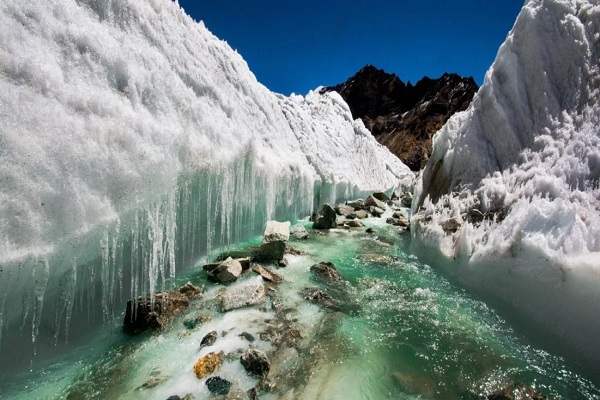

Prof Indra Shekhar Sen, Earth Science Department, IIT Kanpur
The glacier-ice meltwater from the mighty Himalayas is feeding the major river systems in India including the Indus, Ganga, and the Brahmaputra. However, due to the adverse effects of global warming, the Himalayan glaciers are retreating. Hence, IIT Kanpur has conducted a study to track the amount of water contributed by the glaciers to the rivers by using oxygen and hydrogen isotopes, writes Adarsh Som of Elets News Network (ENN).
According to the new study conducted by Prof Indra Shekhar Sen and his PhD student Soumita Boral at Earth Science Department of IIT Kanpur, stable water isotope data of six Himalayan glacier-fed rivers such as the Indus, the Ganga, the Brahmaputra, the Mekong, the Salween, and the Yangtze were used to determine the source contributions to these rivers 2000 meters above mean sea level. The research states that each river has a different dependency on the Himalayan glaciers, precipitation, and groundwater. Stable isotopes of water have been successfully used over many decades to quantify the contribution of groundwater, glacial meltwater, snow meltwater, and rainwater to river discharge.
The Indus river had the highest glacier-ice meltwater dependency as the annual average glacier meltwater contribution was 47 ± 13 percent that is nearly half of the river flow. The Ganga river which rises from the Gangotri glacier system had the second-highest contribution of glacier-ice meltwater which is 44 ± 13 percent. However, the Brahmaputra had lesser glacier-ice meltwater contribution 29 ± 10 percent and is more dependent on the contributions from groundwater, snow meltwater, and rainwater. Moreover, the highest glacier-ice meltwater contribution in all the studied river basins was during the monsoon and the post-monsoon or between the months July to November, the study reveals.


Soumita Boral, PhD scholar, Earth Science Department, IIT Kanpur
The researcher explains the retreating glaciers, ice-meltwater contribution and its significance with an example stating, imagine your earnings have decreased and you have to draw money out from your savings account which was for emergency purposes. But, if this situation continues for a very long time wherein your debit amount exceeds far more than your credit amount, then soon the savings account will become empty! Thus, this savings account acts as a buffer only but you have to estimate in advance your dependency on your savings and act accordingly.
On similar lines, the Himalayan glaciers act as a buffer for the rivers to maintain their flow against change in precipitation and preventing drought-like situations, especially when the rains fail. However, the matter of concern is the Himalayan glaciers are not getting replenished at the same rate at which it is melting, hence, are rapidly shrinking. Thus, to manage the water resources effectively it becomes important to know to what extent these rivers rely on the glaciers.

In order to provide an answer to this, the study further calculated that 33.5 ± 6.5 Gt (1 Gt = 1012) of ice mass melts each year to sustain the three rivers the Indus, the Ganga, and the Brahmaputra. Of this, 13.5 ± 4.2 Gt of ice drains in the Indus River which is the largest share of three. As per the researchers, this is the first estimate of total ice-mass loss from the Himalayas and it is critical not only to understand river flow but also to identify the impact on glacier derived products that maintain downstream ecosystems. Moreover, it is important to note that the total ice mass loss estimate is different from net ice-mass loss estimates from other published studies. The net ice-mass loss is the balance between the melted ice mass and the accumulation from snowfall during the accumulation season. The researchers clarify that though the net ice-mass loss estimates are important to gauge the glacier sustenance, and sea-level rise, only the total ice mass loss reflects the real dependence of the rivers on the glaciers.
According to researchers, the findings are based on 842 actual ground-observed data which is rare for studies conducted on the Himalayas due to its remote location and difficult accessibility to the glaciers. This study has been published in Geochemical Perspectives Letters (doi: 10.7185/geochemlet.2013). For the research article, click on the link below: https://www.
Be a part of Elets Collaborative Initiatives. Join Us for Upcoming Events and explore business opportunities. Like us on Facebook , connect with us on LinkedIn and follow us on Twitter, Instagram.











